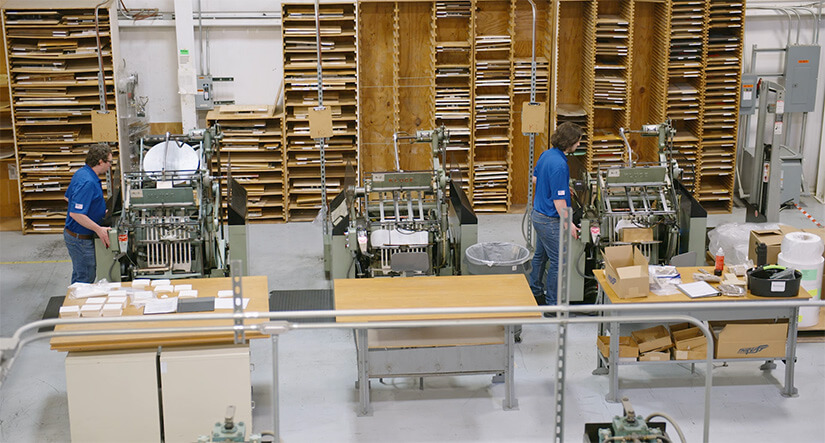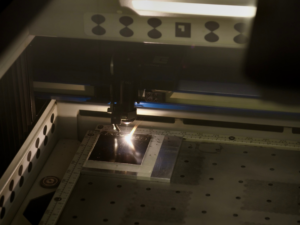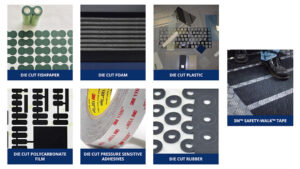Overview Summary
- Global supply chain volatility continues to impact precision die-cut components, especially those requiring specialty foams, films, and adhesives.
- Material shortages are evolving due to regulatory changes, feedstock pressures, and growing demand from electronics and EV industries.
- Tariffs, geopolitical tensions, and unpredictable transit times make offshore sourcing riskier and less cost-stable.
- Manufacturers are shifting toward smarter inventory strategies, including VMI, safety stock, and collaborative forecasting.
- Domestic converters offer shorter lead times, faster prototyping, better communication, and lower logistics risk compared to offshore suppliers.
- Partnering with a reliable U.S.-based converter can significantly increase supply chain resilience for precision die-cut components.
 Manufacturers face a level of supply chain uncertainty that would have seemed unlikely a decade ago. Precision die-cut components, small, custom-shaped parts that often play a critical role in sealing, insulating, cushioning, or bonding assemblies, are uniquely sensitive to disruptions. When these components are delayed, out of spec, or difficult to source, production schedules, cost projections, and product launches can quickly be affected.
Manufacturers face a level of supply chain uncertainty that would have seemed unlikely a decade ago. Precision die-cut components, small, custom-shaped parts that often play a critical role in sealing, insulating, cushioning, or bonding assemblies, are uniquely sensitive to disruptions. When these components are delayed, out of spec, or difficult to source, production schedules, cost projections, and product launches can quickly be affected.
Understanding today’s global risks is essential for any manufacturer that depends on consistent, high-quality die-cut parts.
Material Shortages Are Changing, Not Disappearing
Specialty materials like foams, films, pressure-sensitive adhesives, insulation media, thermal pads, and high-performance plastics have experienced recurring shortages since 2020. Although supply has stabilized for many categories, new risks are emerging:
- Regulatory shifts affecting adhesive chemistries
- Growing demand driven by electric vehicles, electronics, and renewable energy
- Rationalization among material suppliers, reducing the number of producers
- Feedstock volatility that impacts plastics, rubber, and foam formulation
When a precision component requires a very specific material, there is often no easy substitute. This makes proactive material recommendations and stocking strategies essential.
Geo-Politics and Tariff Considerations are a Constant Variable
Manufacturing supply chains with offshore suppliers face more complexity than ever:
- Tariffs can increase costs with little notice
- Port congestion or closures may delay shipments for weeks
- Transit times have become less predictable
- Political instability can disrupt entire trade corridors
For precision die-cut components, where production lines often depend on weekly or even daily deliveries, uncertainty becomes a direct operational risk.
Inventory Strategy Matters More Than Ever
Companies once relied heavily on just-in-time delivery. Today, that approach requires a more nuanced strategy:
- Vendor-managed inventory (VMI) programs
- Strategic safety stock on critical materials
- Collaborative forecasting with converting partners
- Dual-sourcing or multi-material options where feasible
The strongest supply chains are those that combine fast domestic production with insightful demand planning.
Domestic Converters vs. Offshore Suppliers: A Different Type of Value
Evaluating suppliers based on unit cost alone is no longer enough. Companies now weigh the total impact on lead time, risk, and flexibility.
Domestic converters offer:
- Shorter, more predictable lead times
- Faster prototype-to-production execution
- Easier technical collaboration
- Lower transit risk and freight volatility
- Greater transparency and quality control
Offshore suppliers often provide:
- Competitive unit pricing
- High-volume capacity
BUT offshore suppliers also introduce longer lead times, communication challenges, and less flexibility, factors that can negate cost savings when a part is critical to production uptime.
How Supply Chain Risks Affect Lead Time and Cost
Supply chain instability doesn’t just increase risk—it affects day-to-day operations in real, measurable ways:
- Longer lead times for materials and finished components
- Higher freight costs, especially during market swings
- Price unpredictability due to tariffs and currency fluctuations
- Emergency expediting to keep lines running
- Delays from quality issues when communication or specs aren’t aligned
Precision components can become a bottleneck if sourcing isn’t steady and predictable.
Strengthening the Supply Chain with a Reliable Domestic Partner
Manufacturers are increasingly turning to domestic precision converters to stabilize their supply chain. Thrust Industries supports this shift by providing:
- Rapid prototyping and fast, repeatable production
- Material expertise across foams, films, adhesives, and specialty substrates
- ISO-certified processes and tight-tolerance fabrication
- Scalable production that grows with your program
- Direct communication with experienced engineers and project managers
This combination of speed, technical capability, and reliability helps manufacturers reduce risk across every stage of product development and production.
Building a More Resilient Future for Precision Components
Global supply chain challenges aren’t going away; they’re simply evolving. Manufacturers that adjust their sourcing strategies now will be better equipped for the next wave of disruptions. By strengthening relationships with domestic converting partners and rethinking inventory strategies, companies can protect their production schedules, reduce uncertainty, and maintain consistent quality.
If you’re evaluating ways to make your precision die-cut component supply chain more resilient, contact Thrust Industries to explore your options.

 Thrust Industries Expands Capabilities with New Cutting Technology
Thrust Industries Expands Capabilities with New Cutting Technology  What’s the Difference Between Die Cutting and Laser Cutting?
What’s the Difference Between Die Cutting and Laser Cutting?  Step-by-Step: Understanding the Custom Die Cutting Process
Step-by-Step: Understanding the Custom Die Cutting Process  Improving Placement Efficiency and Accuracy with Die Cut Tapes
Improving Placement Efficiency and Accuracy with Die Cut Tapes  Seven of the Most Popular Die Cut Materials Used in Manufacturing
Seven of the Most Popular Die Cut Materials Used in Manufacturing